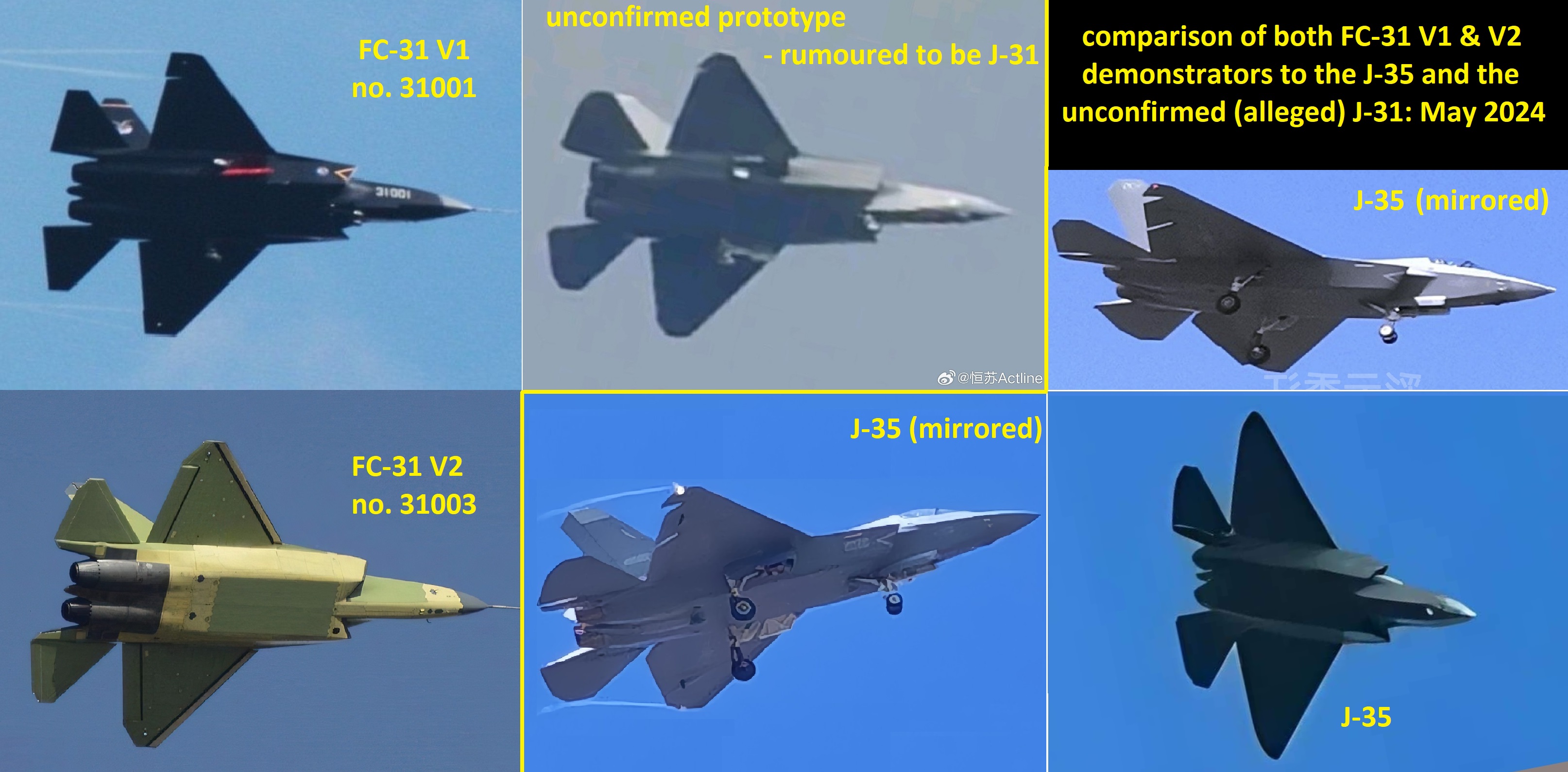A recent image suggests China is advancing work on a land-based version of its FC-31/J-35 stealth fighter. The photographs of the prototype fighter indicate significant design differences from the carrier-based J-35, which has been the focus of recent development.
The image, shared by Chinese aviation researcher @Rupprecht_A on May 29, has sparked considerable interest in the aviation community. The aircraft has been in the limelight for months, partly due to its carrier-based mockup displayed on China’s third aircraft carrier.
This new development represents a return to the fundamental principles and origins of the program, reflecting a renewed focus on aspects that initially prompted its inception.
The first two FC-31 prototypes in the image were designed as land-based fighters. However, interest waned, and the design was adapted for carrier operations, resulting in the J-35.
The manufacturer, Shenyang Aircraft Corporation, appears to be revisiting the land-based variant alongside the J-35.

The photo offers the most detailed view yet of what seems to be the new land-based version of the jet, currently called the J-31. Numerous compelling indications suggest that this aircraft goes beyond being just another J-35 prototype.
The J-31 has a smaller wing surface area — where the horizontal tail surfaces intersect with the wing — than the J-35. In contrast, the J-31 features a small gap between these surfaces.
Additionally, the landing gear configuration on the J-31 differs from its J-35 counterpart. It features a distinctive single-nose wheel arrangement in contrast to the twin-wheel setup observed on the J-35.
The absence of a catapult launch bar on the J-31, a feature on the J-35, further supports this distinction.

However, the mysterious prototype is probably the same one that was also sighted last year. In September 2023, an image surfaced on a Chinese aerospace blog accompanied by a caption indicating that the inaugural flight of the first J-31 prototype took place over Shenyang.
Coinciding with this revelation, there was speculation regarding China’s development of a new land-based variant of the J-35.
Why The New Land-Based Variant?
While the precise motivation behind this development remains unclear, analysts speculate various reasons ranging from domestic military interest to foreign export opportunities.
In January 2024, Pakistan announced its intention to acquire an unspecified number of FC-31 stealth fighter jets from China. According to Chinese experts, this move is expected to expand the international market for Chinese aircraft, potentially driving the need for further refinement of the FC-31 design.
The unveiling of the new land-based variant could be seen as an effort by the manufacturer to fine-tune the aircraft’s capabilities before offering it to potential foreign buyers.
The FC-31 design has undergone iterative refinements since its initial demonstration, with subsequent prototypes incorporating numerous changes.
The transition to the carrier-based J-35 variant introduced additional modifications tailored to naval operations, including enhancements such as strengthened landing gear.

Despite the renewed focus on the land-based variant, the FC-31/J-35 has already garnered significant attention for its potential role in China’s aircraft carrier program. China’s state-owned Shenyang Aircraft Corporation is working to modify this fifth-generation aircraft for naval operations.
The J-35 features a cockpit layout and canopy modeled after the F-35B, providing improved visibility for the pilot. Its reinforced landing gear and foldable outer-wing panels optimize performance on carrier decks, while its advanced active electronically scanned array (AESA) radar enables superior situational awareness.
Speculations suggested that the J-35s would be deployed on China’s next-generation carriers, equipped with catapult launch systems. However, recent sightings of a J-35 mockup undergoing tests aboard the Liaoning aircraft carrier, which relies on ‘ski jump’ ramps for takeoffs, raise the possibility of deploying the fighter on existing carriers.
For a considerable time, it was widely assumed that Beijing would persist in deploying J-15 fighters from Shandong and Liaoning, equipped for short takeoff but arrested recovery (STOBAR) missions.
However, future CATOBAR (Catapult Assisted Take-Off But Arrested Recovery) carriers, exemplified by vessels like Fujian boasting of improved capabilities, are anticipated to host J-35s along with J-15 CATOBAR variants, complemented by various aircraft and unmanned aerial vehicles.
If the aircraft is undergoing modifications for exports, it may attract significant interest from numerous countries not aligned with the United States. This interest could arise from various factors, such as the aircraft’s cost-effectiveness, stealth features, and potential to enhance a buyer’s military capabilities.
- Contact the author at ashishmichel(at)gmail.com
- Follow EurAsian Times on Google News




